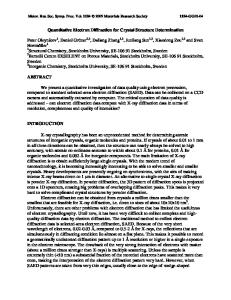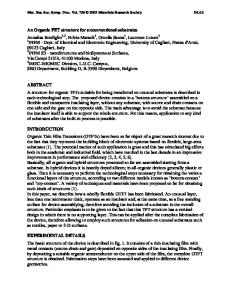Unconventional Electron Microscopy for Molecular Structure Determination
- PDF / 34,689,095 Bytes
- 227 Pages / 439.37 x 666.142 pts Page_size
- 23 Downloads / 293 Views
Edited by W. HOPPE and R. MASON
Volume 7
Unconventional Electron Microscopy for Molecular Structure Determination
W. HOPPE and R. MASON (Eds.)
Unconventional Electron Microscopy for Molecular Structure Determination With contributions of B. M. SIEGEL· A. V. CREWE· M. S. ISAACSON· E. ZEITLER E. KELLENBERGER· J. KISTLER· V. E. COSSLETT O. SCHERZER· J. GASSMANN· W. HOPPE· D. TYPKE
With 88 figures
Friedr. Vieweg & Sohn Braunschweig/Wiesbaden
CIP-Kurztitelaufnahme der Deutschen Bibliothek Unconventional electron microscopy for molecular structure determination/W. Hoppe and R. Mason (eds.) With contributions of B.M. Siegel ... Braunschweig, Wiesbaden: Vieweg, 1979. (Advances in structure research by diffraction methods; vol. 7) ISBN-13: 978-3-528-08117-1 e-ISBN-13: 978-3-322-86362-1 DOl: 10.1007/978-3-322-86362-1 NE: Hoppe, Walter (Hrsg.]; Siegel, Benjamin M. (Mitarb.]
1979 All rights reserved
© Friedr. Vieweg & Sohn Verlagsgesellschaft mbH, Braunschweig 1979 Softcover reprint of the hardcover 1st edition 1979
No part of this publication may be reproduced, stored in a retrieval system or transmitted mechanically, by photocopies, recordings or other means, without prior permission of the copyright holder. Set by Vieweg, Braunschweig
ISBN-13: 978-3-528-08117-1
Preface
Generally it is not sufficiently appreciated that electron microscopy is in fact a diffraction method. In essential aspects electron microscopes are more closely related to X-ray diffracto· meters than to light microscopes. In electron microscopes monochromatized radiation and coherent illumination (never used in light microscopy) correspond in X-ray diffractometers to the primary beam with a small divergence. Imaging ina general sense can take place in interference experiments between a primary beam and a scattered beam, or between different deflected scattered beams. This leads to the realization of an old dream in diffractometry, namely to a general experimental solution of the "phase problem". The most impressive analogy, however, concerns the potential of the electron microscope as a tool for structure determination (where the radiation wavelenght is smaller than the atomic distances). It was therefore considered timely to treat this topic in this series. It was a fortunate cioncidence that in 1976 a Workshop on "Unconventional Electron Microscope Methods for the Investigation of Molecular Structures" (sponsored by the European Molecular Biology Organisation, the Deutsche Forschungsgemeinschaft and the Max-Planck-Gesellschaft) took place, and that most speakers presenting introductory lectures agreed to publish their contributions in an expanded version in this volume. This volume is thus not a symposium report in the usual sense since it contains the majority of these introductory lectures only. For completeness an article on scanning transmission electron microscopy and on electron microscopy of periodical arrays has been added. This book is meant as an introduction into a new and fascinating topic. For more detailed information the rea










